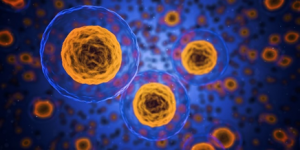Tiré du chapitre 4.3 du livre : Vivre jeune 4 – Ne soyez pas esclave de votre génétique
Tout au long de notre vie, le système immunitaire est en constante évolution. Étant donné qu’il doit nous défendre contre les infections du monde extérieur, il passe une partie de notre jeune enfance à apprendre ce qui est le « soi » et le « non-soi ». Il doit distinguer ce qui fait partie de notre corps et ce qui n’en fait pas partie, afin de ne pas réagir contre nos propres organes et nos propres tissus. Malheureusement, il peut arriver qu’il se dérègle et attaque certaines parties de notre corps comme les muscles (myopathie), les organes (Lupus), les nerfs périphériques (neuropathie périphérique), l’enveloppe des nerfs (sclérose en plaques), les articulations (polyarthrite rhumatoïde) ou les cellules du pancréas (diabète de type 1). C’est ce qu’on appelle les maladies auto-immunes.
Dans ce premier article, nous essaierons de vous expliquer le fonctionnement du système immunitaire, mais aussi certaines réalités concernant nos habitudes de vie qui peuvent nuire ou aider à son bon fonctionnement. Il existe beaucoup de croyance concernant l’usage du citron et de certains trucs de grand-mère. Par exemple, le citron dans votre thé, c’est bon pour le goût, cela n’en fera pas un remède contre la grippe. Il n’y a toutefois pas d’inconvénient à le faire si cela vous rassure ou que c’est devenu une tradition.
Le système immunitaire inné ou acquis
On entend souvent dire qu’il est nécessaire d’être en contact avec les microbes pour développer notre système immunitaire. Pourquoi au juste ? Est-ce vrai ? Pensez-vous que nous vivons dans un monde trop aseptisé ?
Le système immunitaire possède deux grandes lignes de défense : les défenses innées et les défenses acquises.
 Les défenses innées réagissent rapidement à tous types d’envahisseurs, en causant de l’inflammation et elles sont non spécifiques. Elles répondront pratiquement de la même façon pour différents types d’infections. Les cellules du système immunitaire inné se nomment les cellules tueuses naturelles (NK pour natural killer en anglais), les granulocytes (différents types) et les phagocytes (dont les macrophages).
Les défenses innées réagissent rapidement à tous types d’envahisseurs, en causant de l’inflammation et elles sont non spécifiques. Elles répondront pratiquement de la même façon pour différents types d’infections. Les cellules du système immunitaire inné se nomment les cellules tueuses naturelles (NK pour natural killer en anglais), les granulocytes (différents types) et les phagocytes (dont les macrophages).
Les défenses acquises, quant à elles, sont basées sur la reconnaissance d’un antigène. Le système immunitaire reconnaît certaines molécules qu’il associe à des bactéries ou des virus. C’est comme si, lors d’une infection, le système immunitaire acquis prenait des notes pour être en mesure de réagir plus efficacement la fois suivante. Ce sont ces « notes » que l’on transfert via les vaccins, afin que le système réponde efficacement aux maladies graves, même s’il n’a jamais été en contact auparavant. L’idée est simple : plusieurs des maladies graves pour lesquelles nous vaccinons risquent de tuer ou de laisser invalides les gens lors d’une première infection. Les vaccins fournissent ainsi les « notes » ou « le manuel de défense » nécessaire pour répondre, comme si on avait déjà eu la maladie et qu’on avait survécu. Cette réponse est moins rapide que la réponse innée, mais plus efficace. Ce sont les cellules que l’on appelle les lymphocytes qui produisent les anticorps (lymphocytes B) et qui reconnaissent les antigènes afin de coordonner l’attaque (lymphocytes T).
Malheureusement, le système n’est pas parfait et interprète parfois des protéines dites « allergènes », reconnues par les « notes » du système acquis, comme étant des intrus dangereux. Il cause alors une réponse parfois disproportionnée pouvant être dangereuse comme les allergies aux arachides.
Les anticorps sont les molécules qui reconnaissent spécifiquement des protéines bactériennes ou des virus (le « non-soi » = protéines ou molécules que l’on appelle les antigènes) et qui permettent d’identifier ces intrus avec des étiquettes (anticorps) pour qu’ils soient reconnus comme des intrus et détruits rapidement par les guerriers du système immunitaire.
Il est donc en partie vrai que le contact avec notre environnement permet de développer le système immunitaire. Les bonnes bactéries de notre intestin en sont un exemple intéressant et elles sont nécessaires au fonctionnement équilibré du système immunitaire. Le système immunitaire est constamment en équilibre, prêt à nous défendre ou à produire de l’inflammation.
Il faut savoir que l’inflammation systémique légère, l’inflammation dans tout le corps, augmente en vieillissant et elle est reliée à l’augmentation des risques ou de la vitesse de développement d’un grand nombre de maladies.
Une étude récente a même démontré qu’une mauvaise alimentation reprogrammerait certaines réponses immunitaires. Le système immunitaire inné réagirait rapidement à une alimentation riche en gras et en sucre. Il causerait ainsi une inflammation systémique similaire à celle d’une infection bactérienne.
Il s’agit de résultats obtenus à partir de souris, mais le plus intéressant, c’est que ces souris ont conservé une mémoire de cette alimentation qui facilite l’inflammation. Il s’agit d’un processus de programmation épigénétique de l’usage de certains gènes.
 Cette mémoire, qui est présentée comme « l’entraînement du système immunitaire inné », est reliée à certains marqueurs qui ont été identifiés par la suite dans les cellules sanguines de 120 personnes. Certaines de ces personnes avaient des marqueurs forts du système immunitaire, reliés à la consommation de malbouffe. Ainsi, cette mémoire identifiée chez l’animal serait aussi présente chez l’humain. L’entraînement du système immunitaire inné rendrait les processus inflammatoires plus agressifs. Les gens consommant de l’alimentation rapide ont plus de risques d’avoir des problèmes d’inflammation et/ou une inflammation systémique trop élevée. Cela augmente les risques de maladies cardiovasculaires, de dégénérescence nerveuse, les problèmes d’articulations, de douleur, les allergies, la prise de poids, et plusieurs autres problèmes de santé reliés au vieillissement.
Cette mémoire, qui est présentée comme « l’entraînement du système immunitaire inné », est reliée à certains marqueurs qui ont été identifiés par la suite dans les cellules sanguines de 120 personnes. Certaines de ces personnes avaient des marqueurs forts du système immunitaire, reliés à la consommation de malbouffe. Ainsi, cette mémoire identifiée chez l’animal serait aussi présente chez l’humain. L’entraînement du système immunitaire inné rendrait les processus inflammatoires plus agressifs. Les gens consommant de l’alimentation rapide ont plus de risques d’avoir des problèmes d’inflammation et/ou une inflammation systémique trop élevée. Cela augmente les risques de maladies cardiovasculaires, de dégénérescence nerveuse, les problèmes d’articulations, de douleur, les allergies, la prise de poids, et plusieurs autres problèmes de santé reliés au vieillissement.
En vieillissant
En vieillissant, l’incidence de certaines maladies augmente parce que le système immunitaire a tendance à se dérégler. Cela est très caractéristique du vieillissement. C’est l’augmentation constante de l’inflammation légère systémique que l’on appelle en anglais « l’inflammaging » pour « inflammation-vieillissement ». Il s’agit de la production de molécules qui stimulent l’inflammation (molécules pro-inflammatoires) par les cellules vieillissantes. Ce processus est présent à des niveaux plus ou moins importants pour toutes les personnes vieillissantes. Il nuit au bon fonctionnement du corps humain et facilite le développement d’un grand nombre de maladies. Bonne nouvelle : l’efficacité du système immunitaire, de même que le niveau d’inflammation systémique, sont directement reliés à nos habitudes de vie. Comme nous venons de le mentionner précédemment, l’alimentation rapide, riche en gras et en sucre est à éviter.
Pour les facettes positives, afin de maintenir un bon système immunitaire, il est important de :
En ce qui concerne l’alimentation, il est possible de réduire la consommation d’aliments dits « pro-inflammatoires » (la viande rouge, les produits laitiers et les sucres raffinés) et d’augmenter la consommation des aliments dits « anti-inflammatoires » (poissons gras, huile d’olive, grains entiers, légumes, noix, produits de la mer et probiotiques). Ces aliments dits « anti-inflammatoires » sont aussi riches en zinc et en magnésium, deux minéraux essentiels au bon fonctionnement du système immunitaire en vieillissant.
Pour ne rien manquer des recommandations qui aident à maintenir le système immunitaire en santé, restez à l’affût de notre prochain article traitant de ce sujet!
Autres articles suggérés :
- On va tous finir par l’attraper!
- Quercétine et coronavirus : mangez-en si cela vous intéresse!
- Le masque, les risques et la charge virale.
Références:
- Christ et al, 2017. Western Diet Triggers NLRP3-DependentInnate Immune Reprogramming. Cell172, 162–175, January 11, 2018
- Goldberg et Dixit, 2015. Drivers of age-related inflammation and strategies for healthspan extension. Immunol Rev. 2015
- Mejías-Peña et al, 2017. Impact of resistance training on the autophagy-inflammation-apoptosis crosstalk in elderly subjects. Aging (Albany NY). 2017
- Olivieri F et al. Cellular Senescence and Inflammaging in Age-Related Diseases. Mediators Inflamm. (2018)
- Rea IM et al. Age and Age-Related Diseases: Role of Inflammation Triggers and Cytokines. Front Immunol. (2018).






